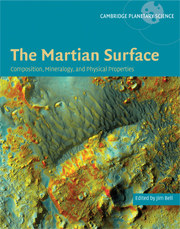Book contents
- Frontmatter
- Contents
- List of contributors
- Foreword
- Acknowledgments
- Part I Introduction and historical perspective
- Part II Elemental Composition: Orbital and in situ Surface Measurements
- 3 Martian surface chemistry: APXS results from the Pathfinder landing site
- 4 Mars Exploration Rovers: chemical composition by the APXS
- 5 Elemental abundances determined via the Mars Odyssey GRS
- 6 Volatiles on Mars: scientific results from the Mars Odyssey Neutron Spectrometer
- Part III Mineralogy and Remote Sensing of Rocks, Soil, Dust, and Ices
- Part IV Physical Properties of Surface Materials
- Part V Synthesis
- Part VI Summary, Upcoming Missions, and New Measurement Needs
- Index
- Plate section
- References
3 - Martian surface chemistry: APXS results from the Pathfinder landing site
from Part II - Elemental Composition: Orbital and in situ Surface Measurements
Published online by Cambridge University Press: 10 December 2009
- Frontmatter
- Contents
- List of contributors
- Foreword
- Acknowledgments
- Part I Introduction and historical perspective
- Part II Elemental Composition: Orbital and in situ Surface Measurements
- 3 Martian surface chemistry: APXS results from the Pathfinder landing site
- 4 Mars Exploration Rovers: chemical composition by the APXS
- 5 Elemental abundances determined via the Mars Odyssey GRS
- 6 Volatiles on Mars: scientific results from the Mars Odyssey Neutron Spectrometer
- Part III Mineralogy and Remote Sensing of Rocks, Soil, Dust, and Ices
- Part IV Physical Properties of Surface Materials
- Part V Synthesis
- Part VI Summary, Upcoming Missions, and New Measurement Needs
- Index
- Plate section
- References
Summary
ABSTRACT
The Mars Pathfinder Alpha Proton X-ray Spectrometer (APXS) was utilized to determine the major and minor elemental abundances of rocks and soils at the 1997 landing site in Ares Vallis. The determined abundances suggest that: (1) the rocks are covered with various amounts of soil; (2) the Soil-Free Rock (SFR) chemistry is similar to that of an evolved SNC-like (SNC – Shergottite, Nakhlite, and Chassignite) igneous tholeiitic basalt-andesite to andesite that is minimally altered (possibly similar to Type 2 TES material); (3) the carbon content is below detection limits for all samples, implying < 5% as MgCO3 (Brückner et al., 1999); (4) the α-mode oxygen abundance indicates that mineral-bound water, above the value for igneous rocks, is present in some rocks and is therefore indicative of some nonigneous alteration and therefore possibly rock-rinds that obscure the petrology of the SFR; and (5) the Pathfinder soils are similar to the Viking fines and may be composed of mafic igneous material like the SNC meteorites and of volatiles deposited from volcanic emissions, as previously suggested by Clark (1993) for the Viking soils.
- Type
- Chapter
- Information
- The Martian SurfaceComposition, Mineralogy and Physical Properties, pp. 33 - 57Publisher: Cambridge University PressPrint publication year: 2008
References
- 1
- Cited by

